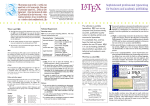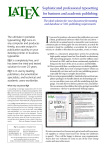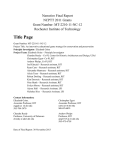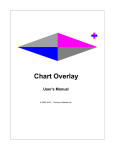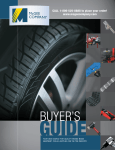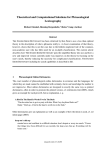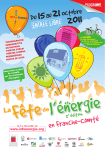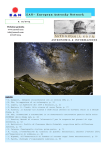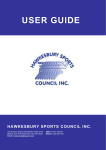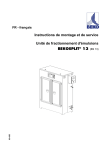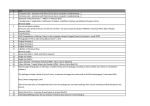Download LaTeX - Formatting Information
Transcript
I LATEX N principio erat verbũ: 7- verbũ erat Sophisticated professional typesetting 9 apud deũ: et de erat verbũ. Hoc erat Typographic resetting of Gutenberg’s 42–line bible of 1452–55, using modern for business and academic publishing in principio apud deũ. Om̃ia p ip̃m Fraktur and decorative initial by Yannis Haralambous. facta sunt: 7- sine ip̃o factum eĆ niĚil. inTheMETAFONT ability to control special characters the insular ampersand (7-) and unusual Quod factũ eĆ in ip̃o vita erat: 7- vita likefeatures like hanging punctuation makes The ideal solution for your document formatting erat lux hominũ: et lux in tenebriŊ luLTEX particularly well suited for critical and teaching editions. and database or XML publishing requirements cet· 7- tenebre eãnõcomp̃henderũt.Fu- typesetting(Beginning of St. John’s Gospel.) a a a a a a a a a a a a a a a a a a a a a a a a a a a a a a a a a a a a a a a a a a a A Technical Requirements Where to get LATEX k k k The TEX Users Group (TUG) distributes a free copy of the TEX Collection DVD with complete systems for major platforms and a copy of the entire CTAN archive to all members annually. Many local and national user groups also participate: check with your nearest group (see TUG Web site for addresses). Operating systems LATEX runs on all current computing platforms. The most common implementations are: System Implementation You can buy a copy with commercial support from any of the vendors listed below. Microsoft Windows Free: ProTEXt (MikTEX), XEMTEX Commercial: see vendor list All the public-domain and open-source implementations are available for free download from CTAN. Linux/Unix Free: TEX Live Apple Mac Free: MacTEX (TEX Live) Shareware: OZTEX, CMacTEX Commercial: Textures All other Contact the TEX Users Group The TEX Users Group (TUG) TUG membership is $85 a year for individuals ($55 for students, new graduates, seniors, and citizens of countries with modest economies) or $95 for non-voting subscriptions (eg publications only). See http://www.tug.org for details of ‘early-bird’ rates and other charges. The institutional rate is $500, which includes up to eight individual memberships. Membership includes the quarterly journal TUGboat and discounts on conference fees: TUG EUROTEX 2007 San Diego, CA Pisa, Italy; Bachotek, Poland 2008 Cork, Ireland — The TEX Collection DVD (from TUG: free to members) contains TEX Live, ProTEXt, MikTEX, MacTEX, and a complete snapshot of the CTAN archive. Hardware k k CTAN — the Comprehensive TEX Archive Network CTAN is an online Internet archive of all free TEX and LATEX software. There are searchable indexes and catalogues at http://www.ctan.org, http://www.tex.ac.uk/, http:// www.dante.de, and http://www.ucc.ie/cgi-bin/ctan . k k Online and other support Internet-based support is available free of charge on the comp.text.tex Usenet newsgroup (available in German as de.comp.text.tex). There is also a two-monthly email newsletter, the TEXhax Digest, and some extensive FAQs listed at http://www.tug.org/tex-ptr-faq . Vendors with commercial support Blue Sky, Inc K-Talk, Inc MacKichan Software MicroPress, Inc Andrew Trevorrow PCTEX, Inc Tom Kiffe TrueTEX, Inc Textures Converters Scientific Word Visual TEX OzTEX PCTEX CMacTEX TrueTEX Mac — Win Win Mac Win Mac Win http://www.bluesky.com http://www.ktalk.com http://www.mackichan.com http://www.micropress-inc.com http://www.trevorrow.com/oztex/ http://www.pctex.com http://www.kiffe.com/cmactex.html http://truetex.com LATEX will run even on old machines, but a 500MHz processor or above is recommended. You should have at least 512Mb of memory, more if you aim to do complex work or use very long documents. You need about 500Mb of hard disk space depending on the options you choose (minimal install is about 250Mb; full is about 1.2Gb). The finer your screen and printer resolution, the better quality you will be able to see and print. A fast inkjet printer or a laser printer is recommended. Software k k k You need a good text editor for creating and maintaining documents: there is a selection included on the TEX Collection DVD. GhostScript and GSview are needed to view PostScript or PDF output (included on the TEX Collection DVD). Adobe’s Acrobat Reader can be downloaded from http://www.adobe.com/ products/acrobat/readstep2.html . A graphics editor or converter is needed if you want to create or modify images (see Figures). The ultimate in portable typesetting: LATEX runs on any computer and produces timely, accurate output in publication quality on your desktop printer or business typesetter. LATEX is completely free, and has been the tried and tested solution for over 20 years. LATEX is in use by leading publishers, documentation specialists, and technical and academic users worldwide. What they say about LATEX I was getting increasingly exasperated with the limitations presented by wordprocessing programs when LATEX came into my life and allowed me to do all those things I previously could only dream of, from unusual symbols to complicated layout. I strongly recommend it to anybody interested in producing a professional-looking document! Petra Hellmuth, Language Specialist k k k LATEX is a document preparation system for producing high-quality output, based on Don Knuth’s revolutionary TEX typesetting program. It’s been used by millions since its launch in 1985, and has been continuously updated to bring you the state of the art in accuracy and flexibility. More powerful than a wordprocessor or desktop publishing system, LATEX has a host of unique features which can dramatically cut time and cost for any publishing project, especially for complex or long documents. Its secret is programmability: hundreds of prewritten templates (packages) to handle almost any formatting task — or you can define your own with the built-in styling language. You only have to say once how any item appears, and all further occurrences then follow your pattern, giving it unrivalled consistency: the key to professional-looking output. I use pdfLATEX and METAFONT not only because I need them to create my presentations, lecture notes and papers but also because it’s fun! Entering a math equation in Powerpoint is a pain in the neck: with pdfLATEX and METAPOST it is a lot easier because you can change the style of what is to be displayed. I have a lecture class from which I generate a lecture presentation and lecture notes all from the same source: I can add text which appears in one or both of the documents. Marc van Dongen, Computer Scientist LATEX is available in Ireland from Silmaril Consultants Bishopstown, Cork [email protected] http://silmaril.ie/ UCC Computer Centre Electronic Publishing Unit 3.22 O’Rahilly Building http://epu.ucc.ie The Irish TEX And LATEX Interest Community (ITALIC) has a mailing list which you can join at http://listserv.heanet.ie/italic-l.html TEX, LATEX, and METAFONT are trademarks of the American Mathematical Society. PostScript, PDF, and Acrobat are trademarks of Adobe Corporation. Macintosh and TrueType are trademarks of Apple Corporation. Windows, Word, and OpenType are trademarks of Microsoft Corporation. Unix is a trademark of Bell Laboratories. Unicode is a trademark of Unicode, Inc. Copyright © 2001–2008 by Silmaril Consultants but may freely be reproduced with this notice intact. I f you need to produce a document for publication you want robust, professional software which won’t let you down — whether it’s an annual report, a manual for your customers, a business plan for your investors, an article for a journal, a book for a publisher, a newsletter for your club or society, or a leaflet or brochure for a product, event, or venue. If you’re convinced, or if you are not, get in touch with your nearest supplier, or contact your local User Group (see addresses in panel). They will be happy to discuss your requirements. You’re also very welcome to come to any of the User Group events and meet other users. Publishing with LATEX Could your next report, article, book, paper, review, or essay benefit from using LATEX? Do you need to be able to exchange reliable documents with colleagues working on other types of computer, without loss of formatting? k k k k k k k k k k Default styles give you immediate, automatic draft formatting for common types of document. Powerful automation features handle cross-references, bibliographic citations, tables of contents, indexes, and glossaries with ease. Automated formatting of formulae, designed by one of the world’s leading mathematicians. Produces industry-standard PostScript (PS) and Acrobat (PDF) files. Available in free and commercial versions (Open Source or with paid support). Heavily supported via the Internet, with user groups in many countries. Huge range of fonts and languages supported, with floating and fixed accents, automatic hyphenation, and language-based typographic rules. Journal and book style files available from leading publishers. Typefaces I find LATEX a powerful instrument for generating elaborate typographic layouts quickly and reliably. They are available for revision for years afterwards, without worries about software versions or compatibility. LATEX is demanding in its requirements but it relieves me of any concern about the finished project. Séamus Ó Direáin, Lexicographer Persistence and reliability LATEX was designed to be independent of any particular manufacturer, make, or model of computer or printer. Unlike some wordprocessor manufacturers’ proprietary file formats, LATEX uses plaintext (ASCII or Unicode) files which can be created and updated with any editor anywhere, and moved between different systems without danger of information loss or corruption. The Historial Colletion Whether you’re using Windows or Unix (including Apple Mac and Linux systems), LATEX works with any Type 1 outline (PostScript) or Type 3 bitmap (METAFONT). In PDF documents, you can also use TrueType and OpenType fonts. This gives you access to tens of thousands of typefaces, both free and commercial. The standard Adobe ‘35’ core PostScript fonts (including Times, Palatino, Century Schoolbook, Helvetica, Zapf Calligraphic etc.) can be used even without a PostScript printer, thanks to the GhostScript and GSview programs which print PostScript output on any printer. The typographics of the TEX formatting engine are very precise: it works internally in microunits (≈53.6Å), resulting in great accuracy in positioning. LATEX can use Anglo-American, Didot, or Adobe points, or metric or imperial units, or any mixture. LATEX also comes with a collection of specialist typefaces for technical, linguistic, and literary typesetting (see adjoining sampler), and the complete mathematics fonts of Computer Modern, Euler, Concrete, and Times. Non-Latin types include Japanese, Chinese, Devenagari, Urdu, Thai, Vietnamese, Coptic, Greek, and many other languages and alphabets, including mixed bi-directional Arabic and Hebrew. The fontmaking programs METAFONT and METAPOST are companions to all TEX systems and can be used to design and implement your own typefaces or special symbols. Cypriot Ereannah Etrusan Linear `B' Phoeniian Runi Rusti Bard Unial D urer Ogham Ugariti Cuneiform The Symbol Colletion Chess Astronomial Cartography BB Dingbats Barodes Logi symbols Genealogy The system has been carefully designed so that documents written years ago can still be typeset. Because the file format has remained virtually unchanged, your investment in intellectual property cannot be damaged by vendors’ arbitrary or planned obsolescence, or by changes in versions or formats. ejej4j didDdi h2hh bBbgbg 0f afaf Bakgammon d efghijkl mn o p q r s t u v w x y z TAAOC LATEX material originally produced for paper printing, no matter how long ago, can quickly and easily be made available for today’s Web access. I have just recently had to provide a journal from 1987–1996 in a format available for the Web. The opening page was converted into HTML for quick scanning on the Web, while the complete articles, with all typesetting and font features (including Hebrew, phonetics, and Greek), were available for viewing in PDF just by re-running the LATEX files. 1bdlm The Non-Latin Colletion IPA Quenya Cree/Inuktitut ABCDEFGHIJKLMNOPQRSTUVWXYZg ABCDEFGHIJKLMNOPQRSTUVWXYZg ^tl ; ^C n^ g Tr^ kt^l k, g ^ b Rzm Ci krp^tl ^C n^ g d Rb^ tl k, ^C n^ g gb Typrph rs rtm mnm Cnsrvtr The Other Sripts Colletion Calligraphi Fraktur Shwabaher `Gothi' Deorative Initials Typographia Ars Artium Omnium Conservatrix Alle Verg angli e i nur ein Glei ni / Da Unzul angli e hier wird' Ereigni; Da Unbes reibli e hier wird' getan / Da Ewig-Weibli e zieht un hinan! HARALAMBOUS If it plese ony man spirituel or temrel to bye any pye` of two and thre omemorai~o` Mathematics TEX-based systems are the only ones capable of automated mathematical formatting. Expressions are entered in symbolic form, regardless of complexity, and are automatically spaced and sized according to mathematicians’ standards: E(n_{g+1}’|n_i’,n_i’’;\,1\le i\le g)=(N’-N_g’)\left[1-\left\{\left(1-\frac{c}{cN’+N’’}\right)^{n_g’d}\left(1-\frac{c}{cN’’+N’}\right)^{n_g’’d}\right\}\right] " ( E(n′g+1 |n′i , n′′i ; 1 ≤ i ≤ g) = (N ′ − Ng′ ) 1 − 1− Available on all platforms from the smallest PC or Mac to the biggest workstation, mainframe, or supercomputer — even some PDAs! Completely portable between systems — document files are all plain text (ASCII or Unicode) and can be edited and processed on any platform, even over a network. a o Typographia Ars Artium Omnium Conservatrix u Nl aon tintean mar do ÷intean fein e Tpographia Ars Artium Omnium onseratrix i Typographia Ars Artium Omnium Conservatrix b Tpographia Ars Artim Omnim onservatri TYPOGRAPHIA ARS ARTIUM OMNIUM ONSERATRIX l T yp ograp h ia Ars Art ium Om ni um Cons e rvat rix v Ty p o g r a p h i a Ar s Ar t i u m Om n i u m Co n s e r v a t r i x s Typographia Ars Artium Omnium Conservatrix n ABCDEFGHIJKLMNOPQRSTUVWXYZ h ABHMOLDGUVTJESCZINQR Typgraphia rs rtium mnium nsratri d t snaklbmr Z OPOPOPOP popopopo RMBJQANS q ABCDEFGHIJKLMNOPQRSTUVWXYZabdefghijkmnqs m %.027ABCDEFGJKLMR`dhmo g Æ j z r A Additional free fonts for use with LTEX cN ′ c +N n′g d 1− ′′ cN ′′ c + N′ n′′g d )# (10.57) After Rapoport (in Bartholomew, D.J. Stochastic Models for Social Processes, 2nd. ed., John Wiley & Sons, 1973, p. 368.) Christina Thiele, CCS Publishing Tables, Figures, and illustrations LAT EX’s tables and figures follow the standard publishers’ practice of ‘floating’, so if there is no room on the current page, they automatically adjust to the next. Automated crossreferencing means that tables and figures can be moved around the document and will always renumber themselves and all their points of reference accordingly. There are powerful controls for tabular settings, allowing both simple and complex designs, with fixed or auto-adjusting spacing, row and column spans, and colouring. Cells, rows, and columns can be aligned top/bottom/middle/left/right/centre or on a decimal point, or formatted as paragraphs. TABLE 6.2: CASES FOR WHICH THE QUANTILE AND KEMSLEY’S METHODS WERE IMPOSSIBLE, CLASSIFIED BY THE SIZE OF σ Method of quantiles σ 0.2–0.4 0.5–0.7 0.8–1.0 All samples Kemsley’s method 5% 10% 5% 10% 2 — — 1 — 1 1 — 2 4 4 15 2 2 The biggest advantage in publishing production is that similar coding of files means anyone can do any journal — there is no need to learn new sets of commands for style variations. Changes in platforms have no effect on production as LATEX is available for all main operating systems. It is possible to separate the writing tasks (creation of text) from the design/layout issues (spacing, fonts, etc), which allows the author simply to identify types of elements (heading levels, foot/endnotes, citations, etc) without getting bogged down trying to remember the text shape and font selections for each element. 4 23 Total no. of samples available 20 22 23 65 Illustration from collection of Don Knuth (artist unknown). After Aitchison, J. and J.A.C. Brown, The Lognormal Distribution, CUP, 1976, p. 62. Spacing can be very precisely aligned to provide better visual appeal. Formal tables and Figures are automatically numbered, and can be captioned, labelled, crossreferenced, and included in a List of Tables and List of Figures. Complex tabular matter can span pages and can be printed landscape (sideways) while retaining the portrait (upright) orientation of the caption and pagenumber. Simple tabular matter can appear anywhere, and stays where it is put (does not float like a formal table), and can also be used for the construction of logos. Figures can contain textual or graphical illustrations. Pictures can be included with scaling, rotation, and clipping: the LATEX default uses the industry standard Encapsulated PostScript (EPS) format, while pdfLATEX can use JPG, PNG, or PDF graphics. ImageMagick, GIMP, Inkscape or other graphics packages can be used for drawing and converting images. LATEX also has a CAD-like vector language for simple diagrams, and there are packages for typesetting musical notation, electronic circuits, flowcharts, and other graphical notations. tion, chapter, page, item, etc), and then refer to it by that name anywhere in the document. Each crossreference is automatically updated so that no matter how much you edit the text, the numbers remain correct. The same method is used for automated indexing, glossary, table of contents, list of figures, list of tables, and bibliographic references. The BibTEX bibliographic database lets you keep all your references separately from your documents, and have them extracted and automatically formatted to any of the standard styles, using numeric, in-text, footnote, or endnote methods. X E 120 100 £ (thousands) 80 C Efficiency Variance D The crossreferencing features let you give a name to any thing you want to refer to (table, figure, sec- Michel Goossens, Sebastian Rahtz, and Frank Mittelbach. The LATEX Graphics Companion. Tools and Techniques for Computer Typesetting. Addison-Wesley, Reading, MA, 1997. Donald Knuth. The TEXbook. Addison-Wesley, Reading, MA, 1986. Leslie Lamport. LATEX, a document preparation system. Addison-Wesley, Reading, MA, 2nd edition, 1994. Tobias Oetiker, Hubert Partl, Irene Hyna, and Elisabeth Schlegl. The (not so) short introduction to LATEX 2ε . Technical Report 3.7, Comprehensive TEX Archive Network, http://www.ctan.org/, Apr 1999. Oren Patashnik. BIBTEXing. Technical report, TEX Users Group, Portland, OR, Feb 1988. 20 F Crossreferences Michel Goossens and Sebastian Rahtz. The LATEX Web companion. Tools and Techniques for Computer Typesetting. Addison-Wesley Longman, Reading, MA, 1999. With Eitan M. Gurari and Ross Moore and Robert S. Sutor. B 40 0 Peter Flynn. Formatting Information — a Beginner’s Guide to LATEX 2ε . Silmaril Consultants, http://www.ctan.org/tex-archive/info/beginlatex/, 3.6 edition, April 2005. Frank Mittelbach, Michel Goossens, Johannes Braams, David Carlisle, and Chris Rowley. The LATEX Companion. Addison-Wesley, Reading, MA, 2nd edition, 1994. Spending Variance 60 Documentation 10 20 30 A 40 50 Volume (Direct labour Hours) (thousands) After R.J. Bull, Accounting in Business, Butterworths, 2nd. ed., 1972, p. 191. The book by Lamport is the user manual for LATEX: make sure you get the second edition for LATEX 2ε . The Companion is more advanced, but useful if you want to implement your own customised document designs. Knuth’s original TEXbook is of interest mainly to computer scientists and typographic programmers who need to know the finest detail. There are dozens of other books, ranging from the online introductions, Formatting Information and The (not so) short introduction to LATEX 2ε , to the professional mathematician’s The Joy of TEX and the typographer’s Digital Typography.


